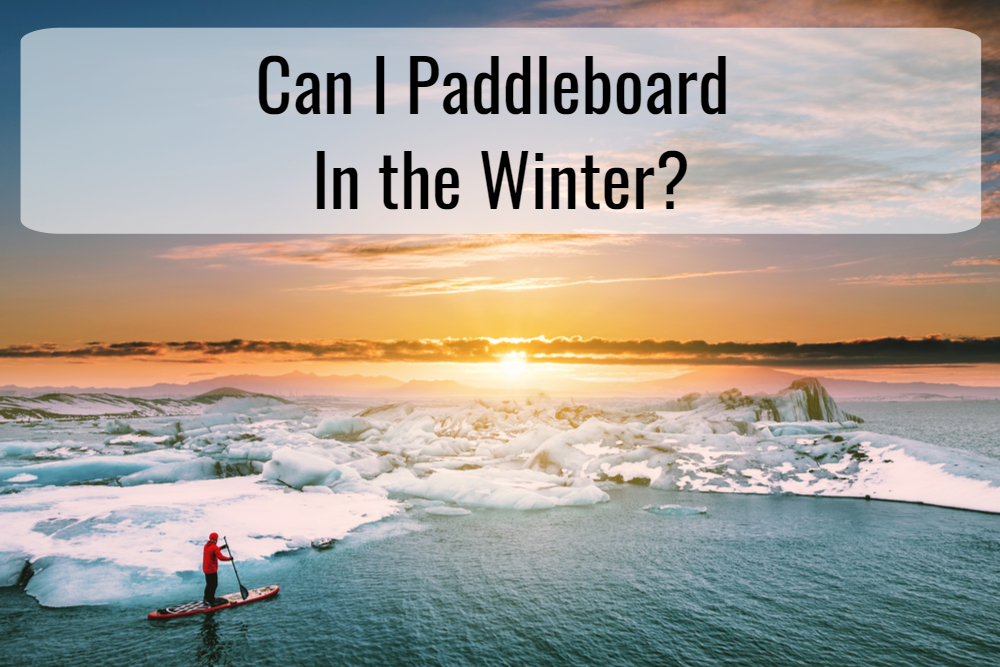
When the weather is nice out it’s easy to grab your SUP and hit the water. What about for those winter months if you live somewhere that has very distinct seasons? Can you stand up paddle board in the winter? The simple answer is yes, of course, you can do anything with your SUP that you want to. However we feel it’s our responsibility to educate you on the reality of stand up paddle boarding in the winter time, or just plain old cold temperatures.
There is so much beauty to be had in cold weather climates that is simply not possible in warm weather areas. At very least, there are bound to be far less people on the water in cooler conditions. Have fun paddling but please be safe out there.
Cold Weather Facts
Winter weather doesn’t always mean snow and ice and it’s important to acknowledge the danger that even cooler air and water temperatures present. We will use the term “cold weather” to acknowledge all “sub optimal weather conditions” below that which would have us indiscriminately switching from paddling to swimming and back again at will in bathing suits.
Colder air and, more importantly, colder water can become a dangerous combination faster than expected in emergency situations. It is not uncommon for individuals to use air temperatures to gauge their paddling gear requirements. Just because the air temperature is comfortable does not mean the water temperature will be as well. Plan accordingly using your local weather apps, USCG data, USGS data, and personal inspection of the water temperature. Always dress for the water temperature.
Cold Shock
Cold shock is used to describe the effects when suddenly immersed in cold water. In most cases it produces a gasping reflex which can potentially fill a victims inner body with cold water. This can also add to the psychological challenge of self recovery. In extreme cases it has also been known to cause immediate fibrillation and cardiac arrest. It’s very important to remain calm immediately during the immersion as this is typically when any extreme movements may be more detrimental to your survival.
Hypothermia
Hypothermia occurs when the prevailing conditions overwhelm the body’s ability to produce and retain heat. It is important to note that this can occur over various periods of time from a several minute fall into extremely cold waters, days of continued exposure, or even weekly exposure if you are already sick.
When winter paddling hypothermia should always be your biggest concern. Take into account the conditions you’ve been exposed to already as well as your current state of health before choosing to go into cold weather conditions. Always have an emergency plan and try not to paddle alone. Float plans, or an itinerary of your paddle plans, are a good idea as well to keep others informed should something happen and you’re out too long.
Thoughts On Paddling Gear
Again we are going to express how important it is to dress for the water temperature. The air may be comfortable but if your paddling mountain fed creeks and rivers that water could be considerably colder. Some basic thoughts on gear choices are:
- Cotton kills – this is a common saying because of the slow drying properties of cotton combined with the evaporative cooling of wet clothes and finally it’s high absorption rate makes for an absolute disaster.
- Insulation wear should be mostly made of synthetic materials as they dry rather quickly, hold onto less water overall, and remain relatively warm once wet.
- Layering should be your goal allowing you to adjust to any changing conditions effectively. Have a dry bag for storing unused layers.
- Emergency or spare clothing is another good idea should you go in with all layers on. It’s always wise to have a reliable warm backup that you can use to get to shore with. Also note that this doesn’t include any post paddle clothing you should already have in your vehicle or at the finish point. This is emergency clothing that is on the board with you.
Wetsuits
Wetsuits get their name from the fact that they are designed to work while wet. Typically it’s a neoprene layer that traps and insulates a layer of water between the suit and skin. These are ideal for occasions when you will be going swimming in the water as well as staying on your paddle board. The downside is that they can become uncomfortable if worn while dry for extended periods of time. They also do not do well when wet in the wind due to the severe effects of wind chill. There are varying sizes, types, and thicknesses of wetsuits meaning that you need to match the conditions to the wetsuit itself. There is no one wetsuit for all cold water conditions.
Drysuits
Like wetsuits, drysuits get their name from the fact they keep you completely dry for whatever part of the body they cover. Drysuits are essentially a moisture barrier to keep your insulation (clothing) dry and prevent wind chill. They are good for floating in the water but not swimming. The drawback to drysuits is that by being completely sealed, they can often cause overheating. You regulate the temperature by changing the layers underneath or by opening specific vents and panels in the suits to let cooler air in. This leads to their second flaw, that if you were to go in with a vent open, or if the suit itself was to be compromised, your insulation would be completely soaked and potentially the drysuit could begin to take on water further weighing you down.
Conclusion
Regardless of which gear you choose, we want you to know that you can most certainly go stand up paddleboarding in the winter. Hopefully you will use this information to make safe choices in regards to the current conditions and your gear options. We think the cool air of winter makes for a fantastic paddling experience. So go on, adventure is calling! And if you are looking for a quality SUP for winter paddling, be sure to check our best inflatable paddle board page.
Thank you for reading our post about paddleboarding in the winter, if you have any questions, comments, or concerns please don’t hesitate to ask us. Remember, hypothermia is a serious concern and to always use your best judgement in colder conditions. Reply in the comments below our reach out to us directly through the contact us form. For now, stay safe and enjoy the winter months paddling. Happy Paddling!
SupBoardGuide
Latest posts by SupBoardGuide (see all)
- Hala Radito Whitewater iSUP Review – 2025 - June 27, 2025
- Hala Atcha 96 Whitewater iSUP Review – 2025 - June 16, 2025
- Thurso Surf Expedition 150 iSUP Review – 2025 - June 12, 2025





